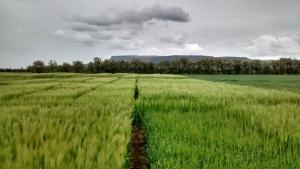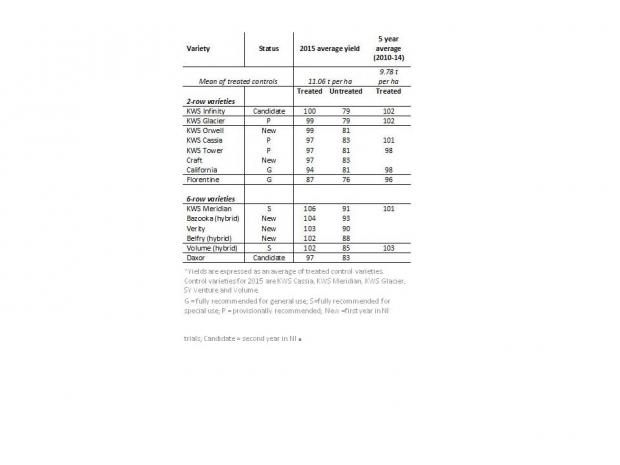Results of the 2015 winter barley variety trials at the Agri-Food and Biosciences Institute (AFBI), funded by DARD and the AHDB (Agriculture and Horticulture Development Board – formerly the HGCA), have just been compiled.

Results
The average treated yield of all varieties across two sites (Limavady and Downpatrick) in 2015 was 10.8 t/ha (86 cwt/ac), 15% higher than the 5-year average. The average treated yields of all varieties in each of the two trials at Downpatrick and Limavady were 11.4 t/ha (91 cwt/ac) and 10.2 t/ha (82 cwt/ac), respectively. In the UK context, the yields in AFBI winter barley trials rank 6th and 8th (Downpatrick and Limavady, respectively) out of 20 trials that range from 6.25 t/ha in Perth, Scotland to 12.05 t/ha in Hertfordshire, England (see http://cereals.ahdb.org.uk/varieties/current-trials-and-harvest-results.aspx).
Performance of six-row varieties
Yields of the six-row varieties were exceptional in 2015. At Downpatrick, Bazooka, the new 6-row hybrid from Syngenta, was the highest yielding variety with an impressive yield of 12.4 t/ha (99 cwt/ac). At Limavady, Volume, the more established 6-row hybrid variety, topped the yields at 11.3 t/ha (90 cwt/ac). On average, Bazooka out-yielded Volume by 2% in treated trials. In untreated trials, Bazooka gave an 8% increase in yield over Volume. At Cereals 2015, Bazooka was billed as higher yielding with better disease resistance than Volume whilst maintaining similar specific weight. The AFBI trial data support this, although there is some degree of variability depending on location. Belfrey, Syngenta’s second new 6-row hybrid, yielded 2% and 5% lower than Bazooka in AFBI trials in the treated and untreated trials, respectively. So Bazooka appears to be the new six row hybrid frontrunner both in terms of treated yields and disease resistance.

Performance of two-row varieties
In recent years, the yields of conventional 2-row winter barley varieties have challenged those of the 6-rows giving the grower both high yields and the quality that comes with 2-row varieties. In 2015, the 2-rows once again gave treated yields that are not too different from those of the 6-rows. On average, KWS Infinity was the highest yielding 2-row giving 11.1 t/ha (89 cwt/ac), 100% of treated controls, just 2% lower than Volume’s yield. The highest 2-row yield in the 2015 NI trials was at Downpatrick, where KWS Infinity yielded 11.7 t/ha (94 cwt/ac). KWS Glacier performed very well, with an average treated yield in both trials of 11.4 t/ha (91 cwt/ac), 99% of treated controls. KWS Orwell, a new 2-row variety gave treated yields of 11.0 t/ha (99cwt/ac), 99% of treated controls, just 1% behind KWS Infinity.
KWS Cassia and KWS Tower gave yields of 10.7-10.8 t/ha (86 cwt/ac), 97% of treated controls. KWS Tower’s yields have not kept up with those of KWS Glacier in general, but the relative performance of these two varieties depends on land type with KWS Glacier tending to perform better on heavy land.
Two-row varieties tend to be more susceptible to disease than 6-rows so their untreated yields (without fungicide) can be markedly lower. This is most notable in KWS Glacier and KWS Infinity, both having yield penalties due to disease in excess of 20% relative to the treated controls. There were indications this year that Florentine, a variety known for its excellent disease resistance, was becoming more susceptible to disease. Its low treated yield of 9.7 t/ha (78 cwt/ac), 87%, puts it 13% behind KWS Infinity. However its untreated yield of 8.4 t/ha (67 cwt/ac), 76%, gives it a yield penalty of 11%, relative to the treated controls. This is low compared to most other varieties, which have yield penalties of 11-21%, with only Bazooka having a similarly low yield penalty of 11%.
Other 2-row varieties in trial include California which had a disappointing year with treated yields of 10.5 t/ha (84 cwt/ac), 94% of treated controls. Craft, a new 2-row variety, gave, along with KWS Cassia, the highest untreated yields of all the 2-rows in trial, 9.2 t/ha (74 cwt/ac), 83% of treated controls.
Conclusion
All results on yield and other characteristics from 2015 add to our knowledge of varieties but when selecting varieties to grow, the five-year average values are more appropriate than results from one year, as the five-year average reflects varietal performance over several seasons. The data from trials in 2015 will be included in the five-year matrices and considered when revising the DARD Recommended List for 2016. More immediately, further information on the harvest results from AFBI variety trials can be obtained from AFBI Crossnacreevy (phone no: +44 (0)28 9054 8000). Variety information is also available here and at www.ahdb.org.uk.
Notes to editors:
AFBI carries out high-quality technology research and development, statutory, analytical, and diagnostic testing functions for DARD and other Government departments, public bodies and commercial companies.
AFBI's Vision is “Scientific excellence in Northern Ireland … serving the world”.
All media enquiries to AFBI Press Office
Latest news
- AFBI Showcases the impact of its Science at this year’s Balmoral Show 29 April 2025
- Finding the needle in a haystack: eDNA as a Surveillance Tool for Plant Pathogens in Northern Irish Forests 23 April 2025
- AFBI issues Nematodirus warning – Spring 2025 11 April 2025
- Managing Nature Based Risks to the UK Economy and Opportunities for Green Finance 08 April 2025
